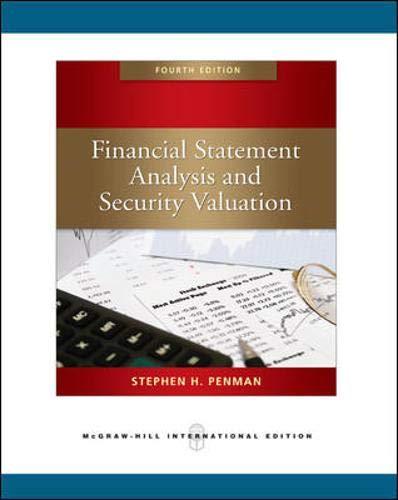Question:
E16.4. Inventory Accounting, P/B, and P/E Ratios: Ford Motor Company (Medium) Ford Motor Company uses the last in, first out (LIFO) method for most of its inventories in its Automotive Division. The amounts of the LIFO reserve reported in footnotes for 1999 were UFO reserve 1999 $1.1 billion 1998 $1.2 billion Ford reported total shareholders' equity of $27.537 billion at the end of 1999 and $23.409 billion at the end of 1998, and it reported earnings for 1999 of $7.237 billion.
 The firm's 1.21 billion outstanding shares traded at $53 at the end of 1999. Ford faces a statutory tax rate of 36 percent.
The firm's 1.21 billion outstanding shares traded at $53 at the end of 1999. Ford faces a statutory tax rate of 36 percent.
a. What would have been Ford's shareholders' equity at the end of 1999 and 1998 if it had used the first in, first out (FIFO) method to record its inventories?
b. What return on common equity would Ford have reported in 1999 if it had used FIFO?
c. Compare Ford's prics-to-book ratios at the end of 1999 under LIFO and FIFO, and ex- plain the difference.
d. Compare the firm's P/E ratio under LIFO and FIFO, and explain the difference.
Transcribed Image Text:
The firm's 1.21 billion outstanding shares traded at $53 at the end of 1999. Ford faces a statutory tax rate of 36 percent. a. What would have been Ford's shareholders' equity at the end of 1999 and 1998 if it had used the first in, first out (FIFO) method to record its inventories? b. What return on common equity would Ford have reported in 1999 if it had used FIFO? c. Compare Ford's prics-to-book ratios at the end of 1999 under LIFO and FIFO, and ex- plain the difference. d. Compare the firm's P/E ratio under LIFO and FIFO, and explain the difference. E16.5. The Accounting for Research and Development and Economic Profit Measures (Medium) Many consultants recognize that expensing R&D investments gives a poor indication of the performance of a firm or its managers because investing in R&D results in lower in- come. So they adjust GAAP accounting by capitalizing R&D expenditures and amortiz- ing the capitalized amount over the estimated life of the revenues that flow from the ex- penditures. a. Below is a series of R&D expenditures that are expected for the years 2009 to 2014 under a firm's R&D program (in millions of dollars). The R&D program began in 2008 with a $100 million investment. Expected net operating assets for the firm are also given for net assets other than those created by the R&D expenditures. Expenditures for R&D are expected to generate $1.60 of revenue over each of the subsequent five years for each dollar spent. Expenses other than R&D expenses are expected to be 80 percent of sales. 2008A 2009E 2010 2011E 2012E 2013E 2014E R&D expenditure Net operating assets 100 80 80 100 100 80 100 80 100 100 100 80 BO 80 Calculate expected operating income, return on net operating assets (RNOA), and residual operating income for each year, 2009 to 2014, under GAAP accounting (where R&D expenditures are expensed against income). Use a required return for operations of 10 percent. b. Now calculate the RNOA and residual operating income for each year under an ac- counting that capitalizes R&D expenditures and amortizes them over five years. c. Compare the RNOA and residual operating income calculated under the two account- ing treatments for each year. Why are they different? d. Forecast RNOA and residual operating income for 2015 under the two accounting treatments. Why do these forecasts differ? e. Value the firm at the end of 2008 using the two different accounting treatments. Do the valuations differ? Why? f. If you tried to value this firm by forecasting only to 2011, what difficulties would you face under the two methods? E16.6. Depreciation Methods, Profitability, and Valuation (Hard) A start-up firm embarks on an investment program in 2009 to manufacture and market a new switching device to be used in communications. The program requires an initial in- vestment of $600 million in plant and equipment, increasing by $100 million each year for four years up to 2013, and then continuing at $1,000 million per year thereafter.
 The firm's 1.21 billion outstanding shares traded at $53 at the end of 1999. Ford faces a statutory tax rate of 36 percent.
The firm's 1.21 billion outstanding shares traded at $53 at the end of 1999. Ford faces a statutory tax rate of 36 percent.






